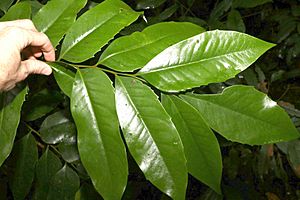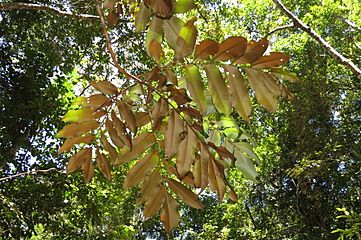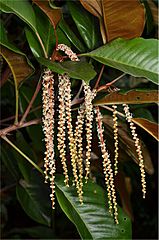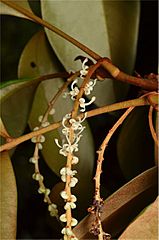Blush silky oak facts for kids
Quick facts for kids Blush silky oak |
|
|---|---|
 |
|
| Foliage | |
| Conservation status | |
|
Least Concern (NCA)
|
|
| Scientific classification | |
| Genus: |
Opisthiolepis
|
| Species: |
heterophylla
|
The Blush Silky Oak (scientific name: Opisthiolepis heterophylla) is a special type of tree. It's the only member of its group, called Opisthiolepis. This tree belongs to the Proteaceae family, which also includes the macadamia nut tree! People also call it the Pink Silky Oak or Brown Silky Oak. It was first discovered and named in 1952. You can only find this tree naturally in a small part of northeastern Queensland, Australia.
Contents
What Does the Blush Silky Oak Look Like?
The Blush Silky Oak is an evergreen tree. This means it keeps its leaves all year round. It can grow very tall, up to 30 meters (about 100 feet). Its trunk can be as wide as 75 centimeters (about 2.5 feet).
Leaves of the Silky Oak
The leaves on older trees are usually simple, meaning they are one piece. They are shaped like an oval or a long ellipse. These leaves can be up to 23 cm (9 inches) long and 9 cm (3.5 inches) wide. They grow on stalks up to 5 cm (2 inches) long. The top of the leaves is shiny green. The underside is silvery white or brown.
Interestingly, the leaves can look very different. Some leaves might be divided into many smaller parts. They can have up to 18 tiny leaflets! This is common in the Proteaceae family.
Flowers and Fruits
The flowers grow in long hanging spikes. These spikes can be up to 15 cm (6 inches) long. They grow where the leaves meet the branch. Each spike has many small flowers, growing in pairs. The flowers are white or cream-colored. They don't have stalks and are smooth. Each flower has four small parts called tepals, about 5 mm long.
After the flowers, the tree produces a woody fruit. This fruit is called a follicle. It is green or brown and measures about 12 cm (5 inches) long and 3.5 cm (1.4 inches) wide. Inside, you'll find several brown seeds. These seeds have wings, which help them fly away in the wind!
How Was This Tree Named?
The Blush Silky Oak was first described by a botanist named Lindsay Stuart Smith. He was a plant expert from Queensland. He studied many plant samples collected in the early 1900s. Most of these samples came from the Atherton Tablelands. Some were also found near Mena Creek and Kirrama National Park.
Smith wrote about this new tree in 1952. His paper was called "Opisthiolepis, a new genus of Proteaceae from Queensland." It was published in a science journal.
Meaning Behind the Names
The scientific name Opisthiolepis comes from ancient Greek words. "Opisthe" means "back" or "behind." "Lepis" means "scale" or "flake." This name refers to a special nectar gland in the flower. It looks like a single scale.
The second part of the name, heterophylla, also comes from ancient Greek. "Heteros" means "different." "Phyllon" means "leaf." This name describes how the leaves look different. Young trees have different leaf shapes than older, mature trees.
Where Does the Blush Silky Oak Grow?
The Blush Silky Oak only grows naturally in northeastern Queensland, Australia. You can find it from near Cardwell north to Mossman. It is very common in the Atherton Tablelands.
This tree grows in rainforests. It can grow in different types of soil. But it grows best in soils that come from basalt rock. You can find it from sea level up to about 1100 meters (3600 feet) high.
Is the Blush Silky Oak Protected?
Good news! Both the International Union for Conservation of Nature (IUCN) and the Queensland Department of Environment and Science list this tree as "least concern." This means it is not currently at risk of disappearing.
Can You Grow a Blush Silky Oak?
Yes, you can! The Blush Silky Oak grows quickly when planted by people. One tree in a garden in Coffs Harbour grew 6 meters (20 feet) tall in just four years. It even started flowering!
Gallery
See also
 In Spanish: Opisthiolepis para niños
In Spanish: Opisthiolepis para niños






